The trans–cisisomerization of an excited molecule converts light energy into mechanical motion, which interacts cooperatively with its surroundings. To understand such a photodynamic process in solids, we investigated the internal twisting motion of 1,1′-diethyl-2,2′-cyanine iodide (DCI) in a series of poly(alkyl methacrylate) (PAMA) polymers by measuring the Young's moduli of the polymers with atomic force microscopy nanoindentation and the fluorescence lifetimes of the dye with time-correlated single photon counting. We found that the isomerization rate constant obtained from the average lifetime correlated well with the mechanical property of the matrix. Our results show that the light-induced molecular motion lies in the modulus-controlled regime in which the polymer matrix not only provides a rigid environment for the dynamics of the molecules but also participates actively in the motion. The concept of elastic modulus may be applicable to molecular rotor dynamics in any synthetic polymer and, in principle, can be extended to biopolymers such as proteins or DNA.

You have access to this article
 Please wait while we load your content...
Something went wrong. Try again?
Please wait while we load your content...
Something went wrong. Try again?


 Please wait while we load your content...
Please wait while we load your content...